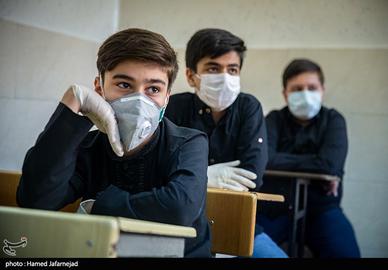Iran’s interior minister reported on September 30 that Iran is at risk of not having enough masks to protect its citizens from coronavirus. “Twenty million masks are produced each day but there are problems in securing the raw material for making them,” he said, adding, "it has been decided that the issue must be pursued and solved. Currently, a mask costs between 1,000 and 1,300 tomans to produce (between US¢25 and ¢31) but there are issues with how they are distributed to the people. So a team has been assigned to study the issue and report on the situation.”
At the beginning of the coronavirus outbreak in Iran in late February, the country suffered a severe shortage of masks and other health equipment, sparking fears among the public. Currently, such items are readily available in the country, although if a person wears one mask per day he will incur a cost of 30,000 tomans (over $7) per month, a heavy financial burden for large, underprivileged households in Iran.
But there are other problems regarding masks. “The distribution of masks...is not being done correctly,” announced Ali Fatemi, vice president of Iran’s Pharmacists Association on July 17. “We are facing an inconsistency. For instance, before coronavirus, Iran produced between 300,000 and 400,000 masks per day but now the production has reached seven million per day. It is only logical that the consumption has increased, but why are the masks not being distributed through the pharmacies?”
Fatemi emphasized that people must not wear masks for more than four or five hours “because the pores in the polymeric layer of the mask are of a certain size that prevents the virus from getting through it. When the humidity of breathing gets too high the mask becomes useless. And when this mask is washed, ironed and reused...the pores expand and particles and viruses can easily get through them. However, people are happy that they have masks, do not observe social distancing and this can lead to the transmission of the disease.”
Infections Among Teachers and Students Surge
On Wednesday, September 30, Iranians woke to the news that several students and teachers had been infected with coronavirus. Schools reopened on September 5, and from the very beginning, parents and some health officials have warned about the consequences of the decision. As September drew to a close, provincial officials announced figures regarding students and students who had been infected, but they were always careful to emphasize that the numbers had nothing to do with school attendance. According to First Deputy Health Minister Iraj Harirchi, from the beginning of the coronavirus outbreak in Iran until just after the reopening of schools, between 100 to 200 students had lost their lives to Covid-19.
On Wednesday, September 30, Saeed Kashmiri, director of the Bushehr Coronavirus Taskforce, reported that since schools reopened, 25 students and four teachers had been infected with coronavirus in the province. In the province of Sistan and Baluchistan, according to Mehdi Tabatabai, vice president of Zahedan University of Medical Sciences, 72 teachers and students had come down with coronavirus in the province. And the situation in the province of Razavi Khorasan appears to be worse. As of September 30, 21 teachers and five students had died from Covid-19. “Two hundred and forty-four of our colleagues in schools and 232 students in Razavi Khorasan have been infected with coronavirus,” said Ghasem Ali Khodabandeh, director general of Razavi Khorasan’s Education Bureau. However, he said, “the numbers we have about infected teachers and students might not be accurate. It is possible that numerous infections have occurred but they have not been reported to us.”
Over the last few days, top government officials have reported that the government is planning to impose fines on people who do not comply with health guidelines, and there has been discussion about legal action being taken against them. On September 30, Interior Minister Abdolreza Rahmani Fazli said: “Government offices, businesses and public places that have already received relevant protocols must report their schedules for implementation to the coronavirus taskforce. Those that are substandard and below average will be issued a warning.”
According to Dr. Sima Sadat Lari, the health ministry spokeswoman, 158 cities in Iran are in a red state of alert and, on average, 10 percent of hospitalized coronavirus patients die. She also reported that discussions are underway to lock down Tehran for a week and allow government employees to work remotely.
Health ministry officials have repeatedly broached the idea of locking down certain areas in various provinces for a week, with the chance that the lockdown could be extended if needed. Now, with the sharp rise in coronavirus cases, this plan might be carried out.
In her daily briefing for September 30, Dr. Lari announced the official coronavirus statistics for the last 24 hours:
Dr. Lari also reported that of the 31 Iranian provinces, currently 30 provinces are in a high state of alert:
How accurate and believable are the official coronavirus statistics announced by Iran’s health ministry? The question has been raised repeatedly since the coronavirus outbreak. “The World Health Organization accepts the statistics when the PCR [Polymerase Chain Reaction test] is positive,” answered Dr. Minoo Moharez, an infectious diseases specialist and a member of the National Coronavirus Taskforce’s Scientific Committee, in an interview. She added, however, that 30 to 40 percent of the tests return false negatives. “That is why 30 to 40 percent of the cases are not reported. If the test is negative but the patients shows symptoms, the doctors tell the patients they have been infected with coronavirus.”
This is part of IranWire's coronavirus chronology. Read the full chronology
visit the accountability section
In this section of Iran Wire, you can contact the officials and launch your campaign for various problems



























comments